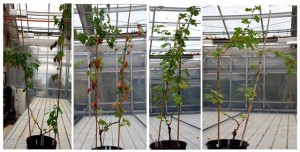Natural Cocktail Developed To Combat Pierce’s Disease

Panel I & II: Xylella fastidiosa inoculated grapevines. PD symptoms at week 8 and 12 post-pathogen inoculation.
Panel III & IV: Xylella fastidiosa inoculated and phage cocktail treated grapevines. Symptoms at week 8 and week 12 post-pathogen inoculation.
Credit: Texas A&M PLoS ONE (Control of Pierce’s Disease by Phage)
All living cells have viruses that prey on them – that includes cells like the bacteria Xylella fastidiosa – which causes Pierce’s disease in grapes.
Using phage technology, scientists at Texas A&M University have now figured out how to use those viruses to combat Pierce’s disease.
“The beauty of [phages] is that the enemy of our enemy is our friend,” says Ry Young, Sadie Hatfield professor of agriculture in the Department of Biochemistry and Biophysics and director of the Center for Phage Technology at Texas A&M.
Young explains that when they were first discovered 100 years ago, these “phages” were thought to be little critters that ate bacteria. But they’re actually just viruses. “When one of these phage particles absorbs into a bacterial cell and injects its DNA, less than an hour later, the cell blows up and hundreds of new phage particles come out, and then those can each go and kill and destroy other cells and generate even more particles,” he says.
It sounds a bit scary, but the phages are actually harmless to humans, animals, and even other bacteria. “If you prepare bacteriophages against the disease agent in Pierce’s disease, which is Xylella fastidiosa, then they won’t attack other bacteria – they only attack Xylella fastidiosa,” Young says.
Carlos Gonzalez, professor in the Department of Plant Pathology and Microbiology at Texas A&M, developed the phage cocktail that combats Pierce’s disease by isolating the phages from the plants and weeds around infected vineyards. “The theory is if you want to find phages against any particular bacterium, you go where that bacterium is growing,” Young explains.
Gonzalez was able to find the phages in the wild, culture them in the lab and put them together to create the cocktail. This cocktail, when injected into the cordons of vines, has been shown to cure and even prevent Pierce’s disease.
Young considers it to be an ideal approach to Pierce’s disease control, because you’re attacking the actual bacteria that cause the disease, rather than the insect vectors, such as sharpshooters, that spread it.
Because the cocktail still has to go through field trials and regulatory and safety testing, it will likely be some time before it’s available to growers.
“I personally think it seems quite clear that these are safe in the sense that the worst that could happen is that they wouldn’t work,” Young says. “The best that could happen is they kill the Xylella bacteria.”










